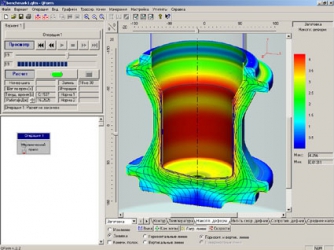1991 – 2002
1998: QForm software
 The next metal process computer simulation development stage was the development and production of the QFORM software in 1998. It features a totally object-oriented and deeply integrated software intended to work in the Windows environment. Unlike the competitors’ packages, the changes did not boil down to drawing up an interface to match the existing core. The software was designed from scratch rewriting all the codes, which took about two years. It also took the whole experience and research results available by that time as well as the state-of-the-art programming techniques, which emerged with the propagation of Windows the world over. To make up for it, the result exceeded all expectations. Presented at the exhibition Forging International in Birmingham, UK, in May 1998 for the first time, QFORM provoked a great interest.
The next metal process computer simulation development stage was the development and production of the QFORM software in 1998. It features a totally object-oriented and deeply integrated software intended to work in the Windows environment. Unlike the competitors’ packages, the changes did not boil down to drawing up an interface to match the existing core. The software was designed from scratch rewriting all the codes, which took about two years. It also took the whole experience and research results available by that time as well as the state-of-the-art programming techniques, which emerged with the propagation of Windows the world over. To make up for it, the result exceeded all expectations. Presented at the exhibition Forging International in Birmingham, UK, in May 1998 for the first time, QFORM provoked a great interest.
The system interface changed totally. It became interactive and graphic. The notions of the pre- and postprocessor per se disappeared, because the data preparation, computation and visualization are combined and simultaneous. The forged part and dies are shown as a realistic 3D graphics, the shape of the workpiece changing on the screen continuously, as the computation advances. The user can switch between the modes and display various fields and other results he is interested in, without interrupting the computation, if he needs to analyze the process before the simulation is complete.
It was for the first time in world practice that the user was enabled to simulate the whole forging impression sequence as a single process chain, including the intermediate cooling or heating operations. Changing one or several data, the user can have the whole chain computed again to create new process options within a single engineering project easily.
The computation model was developed further. The development of the finite element core allowed simulating lap formation efficiently, when a free surface comes in contact with itself, and track the case history of these flaws over the subsequent forging impressions, until the product is finished.
1991: FORM-2D software
The fully automated mathematic simulation became available for manufacturing applications, when FORM-2D software designed for bulk forming finite element simulation was issued in early 1991. The following objectives were set and solved during the development of the software:
- Make the software accessible to forging process engineers with no special training in the field of numerical methods
- Make sure to get guaranteed accurate results no matter what the user’s qualification
- Provide fast computation using accessible and inexpensive PCs
 This was of special importance, because the foreign analogues at that time were exclusively oriented to costly UNIX workstations and inferred a high user qualification in the field of finite elements, since they required manual remeshing control.
This was of special importance, because the foreign analogues at that time were exclusively oriented to costly UNIX workstations and inferred a high user qualification in the field of finite elements, since they required manual remeshing control.
FORM-2D operated under MS DOS and assured the computation of axial-symmetric and flat metal flow to satisfy totally the needs for the simulation of round forgings and simulation of the cross-sections of elongated forgings. The software also calculated tool stresses and deformations efficiently. FORM-2D carried some very essential innovative ideas, which predetermined the development in this field for the years to come.
First, high-order triangular finite elements were used. Their curved borders approximate the complex die and forged part contours far more accurately than linear elements with the same number of nods. In doing so, the complication of algorithms is compensated by a higher solution accuracy in comparison with the foreign analogues using linear elements.
Secondly, the main rule adopted was that under no circumstances should the user interfere with the solution process. The software should work as a ‘black box’, where the user enters the process parameters he can understand to receive the result immediately. To make this happen, efficient methods of finite element mesh generation were developed. The finite element mesh generator based on an adaptive concept plots the mesh using numerous parameters, which may affect the solution accuracy in every point (geometry shape, field gradients, proximity of forming tools and many others). This allowed generating element meshes with the dimensions distributed in the most efficient way, making them denser in the areas with high gradients or creating larger elements where the gradients are not high so that there would be no damage to the solution accuracy. It took high-speed algorithms to be able to generate a new mesh for every step over the time, distributing the computing resources in the most efficient way.
The first night of FORM-2D in the international environment took place during an independent test held at the International Metal Forming Process Simulation Conference in Baden-Baden, Germany, on September 28 thru 30, 1994. Unexpectedly for the other participants in the testing, FORM-2D landed among the best contestants both in terms of accuracy and speed. Notably, it was the only software, which could be used with PCs, rather than workstations. A convenient interface, reliable operation and high accuracy gained the users’ recognition fast and the software was taken up by many factories in Russia and abroad.




